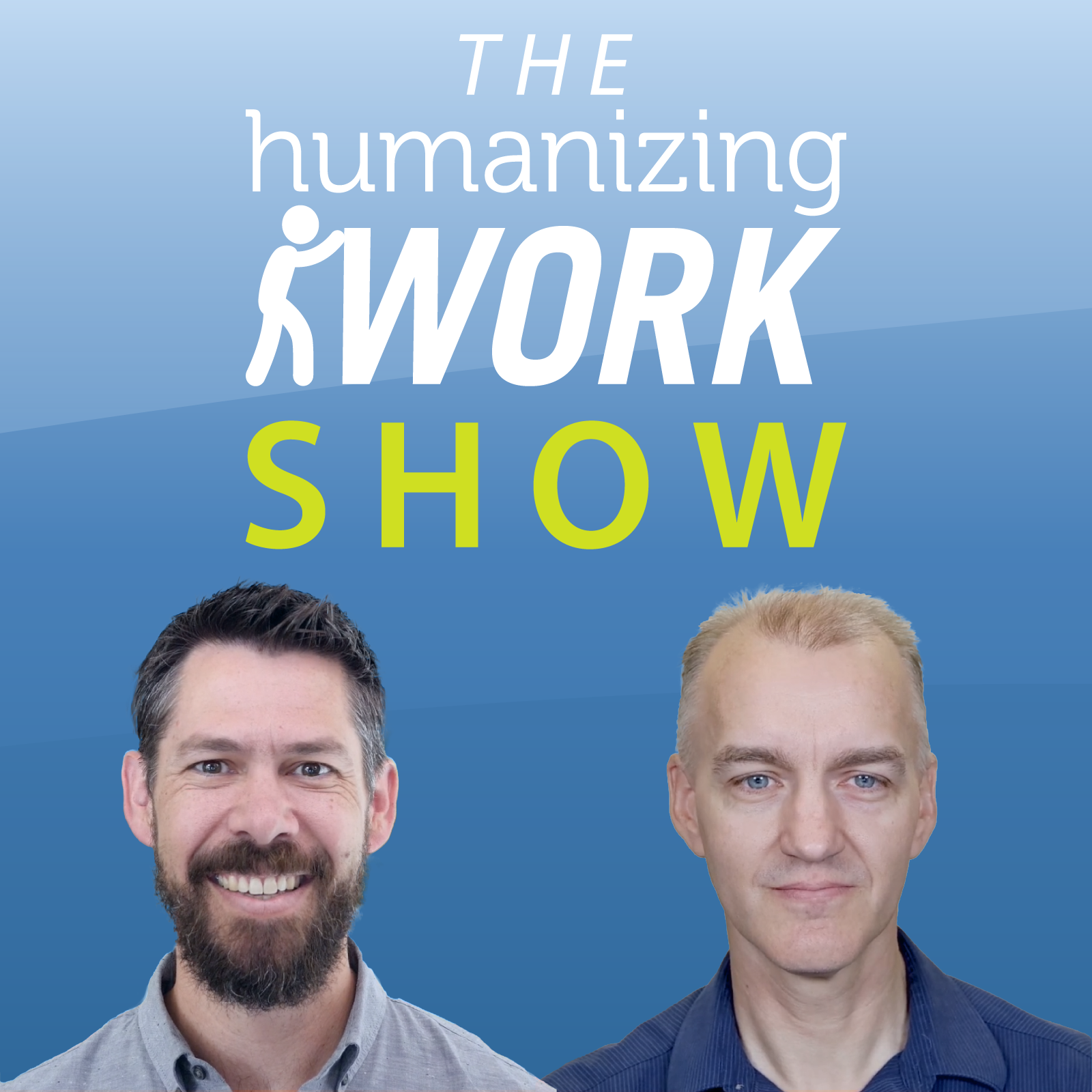Episode Transcript
1
00:00:06,699 --> 00:00:07,466
In the agile
2
00:00:07,466 --> 00:00:11,133
world, there's lots of emphasis
on incremental delivery of value.
3
00:00:11,333 --> 00:00:14,733
Agile, of course, is short for agile
software development,
4
00:00:14,733 --> 00:00:18,733
and in many areas of software development,
it's possible to do frequent releases
5
00:00:18,733 --> 00:00:22,833
and for customers to experience the value
of what you're building as you go.
6
00:00:23,433 --> 00:00:26,433
You don't have to wait
until everything's done to release it.
7
00:00:26,533 --> 00:00:29,333
This is great for your ROI.
8
00:00:29,333 --> 00:00:30,999
It's great for reducing risk.
9
00:00:30,999 --> 00:00:33,233
It's great for learning as you go.
10
00:00:33,233 --> 00:00:35,399
So you're more likely
to build the right thing,
11
00:00:35,399 --> 00:00:37,666
and it makes a huge difference
for motivation.
12
00:00:37,666 --> 00:00:40,999
Meaningful progress is motivating
when you're shipping frequently.
13
00:00:41,333 --> 00:00:44,633
There's a natural force
to prioritize value early.
14
00:00:45,033 --> 00:00:48,666
If you want people to use this new thing
that you're making, it needs to provide
15
00:00:48,666 --> 00:00:50,433
clear value for them.
16
00:00:50,433 --> 00:00:53,066
This causes us to do the complex stuff
17
00:00:53,066 --> 00:00:56,333
early, too,
because complexity correlates with value.
18
00:00:56,733 --> 00:00:59,133
New stuff for humans is complex.
19
00:00:59,133 --> 00:01:00,333
And that's all great.
20
00:01:00,333 --> 00:01:03,266
But we often find ourselves
working with clients who are attracted
21
00:01:03,266 --> 00:01:04,866
to some of the benefits of agile,
22
00:01:04,866 --> 00:01:08,166
but who, for one reason or another, aren't
able to release incrementally.
23
00:01:08,733 --> 00:01:11,733
Maybe there's a hardware component
involved and manufacturing
24
00:01:11,733 --> 00:01:15,366
and everything around that means they're
just not going to ship a little at a time.
25
00:01:15,933 --> 00:01:18,499
Or maybe the regulatory burden on
every release
26
00:01:18,499 --> 00:01:21,499
is a high fixed cost
that precludes frequent releases.
27
00:01:22,066 --> 00:01:23,133
Whatever the reason,
28
00:01:23,133 --> 00:01:27,033
once you give up the idea of incremental
releases, it's easy to drift
29
00:01:27,033 --> 00:01:30,033
back into a traditional project
management approach.
30
00:01:30,066 --> 00:01:33,599
You may be working in iterations,
but you're giving up a lot of the benefits
31
00:01:33,599 --> 00:01:34,299
of agile.
32
00:01:34,299 --> 00:01:37,533
In this situation, it's hard
to reason about how to sequence the work.
33
00:01:37,966 --> 00:01:41,899
Why focus on complex, valuable things
early on if you're not going to ship them?
34
00:01:42,199 --> 00:01:45,033
Wouldn't it be more efficient
to work in dependency order?
35
00:01:45,033 --> 00:01:48,066
Shouldn't we just plan the whole thing
and build it the most efficient way?
36
00:01:48,833 --> 00:01:50,799
In other words,
traditional project management.
37
00:01:50,799 --> 00:01:51,933
With sprints.
38
00:01:51,933 --> 00:01:55,233
There's one mental reframe
that we've found useful for this to help
39
00:01:55,233 --> 00:01:57,599
people get aligned around
the best sequence of the work,
40
00:01:57,599 --> 00:01:59,566
even if you're not going to ship
incrementally.
41
00:01:59,566 --> 00:02:01,266
But before we dive into that,
42
00:02:01,266 --> 00:02:03,899
the humanizing works
Show is a free resource sponsored
43
00:02:03,899 --> 00:02:07,133
by the Humanizing Work Company,
where we help organizations get better
44
00:02:07,133 --> 00:02:10,133
at leadership, product management,
and collaboration.
45
00:02:10,233 --> 00:02:12,133
Visit the contact page on our website.
46
00:02:12,133 --> 00:02:13,166
Humanizing work.
47
00:02:13,166 --> 00:02:15,433
Com and schedule a conversation with us.
48
00:02:15,433 --> 00:02:18,433
If your organization wants to see
stronger results in those areas,
49
00:02:19,066 --> 00:02:21,366
and if you want to support the show,
the best thing you can do
50
00:02:21,366 --> 00:02:23,799
if you're watching on YouTube
is subscribe to the show.
51
00:02:23,799 --> 00:02:25,199
Like and share this episode
52
00:02:25,199 --> 00:02:28,199
and click the bell
icon to get notified of new episodes.
53
00:02:28,233 --> 00:02:30,866
Drop us a comment
with your thoughts on today's topic.
54
00:02:30,866 --> 00:02:33,433
If you're listening on your podcast app,
the best thing you can do
55
00:02:33,433 --> 00:02:36,666
is give us a five star review
and your podcast app and share the episode
56
00:02:36,666 --> 00:02:39,266
along with your thoughts and questions
on your socials.
57
00:02:39,266 --> 00:02:43,233
Okay, here's the reframe that aligns
everyone around the best sequence of work
58
00:02:43,233 --> 00:02:44,666
to get the benefits of agile.
59
00:02:44,666 --> 00:02:47,666
Whether you're shipping frequently or not,
60
00:02:47,766 --> 00:02:50,333
it's this earn green.
61
00:02:50,333 --> 00:02:51,533
Let me explain.
62
00:02:51,533 --> 00:02:54,466
If you've been on a big project
managed in a traditional way, you've
63
00:02:54,466 --> 00:02:59,633
probably experienced stoplight or green
yellow red status reporting a project
64
00:02:59,633 --> 00:03:03,633
or aspects of the project get their status
reported as red, yellow, or green.
65
00:03:04,266 --> 00:03:07,499
Green typically means something like
the project is going
66
00:03:07,499 --> 00:03:10,666
according to expectations
or on schedule or under budget.
67
00:03:10,899 --> 00:03:15,033
Yellow is things are off track for budget,
timeline or whatever,
68
00:03:15,033 --> 00:03:18,833
but we're handling it
and red is we're way off track
69
00:03:18,833 --> 00:03:20,999
and don't have a plan
for saving the project.
70
00:03:20,999 --> 00:03:22,833
We're in crisis mode.
71
00:03:22,833 --> 00:03:24,366
When a project gets started.
72
00:03:24,366 --> 00:03:26,333
Everyone's feeling hopeful.
73
00:03:26,333 --> 00:03:27,933
Nothing new has emerged yet.
74
00:03:27,933 --> 00:03:29,266
You're feeling good about the plan.
75
00:03:29,266 --> 00:03:31,866
So what's the status? Green.
76
00:03:31,866 --> 00:03:33,299
But objectives.
77
00:03:33,299 --> 00:03:36,833
We're facing every risk
we're ever going to face on the project,
78
00:03:36,833 --> 00:03:38,233
whether we know it or not.
79
00:03:38,233 --> 00:03:41,033
Uncertainty is as high
as it's ever going to be.
80
00:03:41,033 --> 00:03:43,566
All our assumptions are untested.
81
00:03:43,566 --> 00:03:45,566
With that reality, what's our status
82
00:03:46,533 --> 00:03:46,999
thing?
83
00:03:46,999 --> 00:03:47,733
Thanks for going.
84
00:03:47,733 --> 00:03:50,733
I've seen this play out firsthand
for over a decade.
85
00:03:50,733 --> 00:03:54,633
I was a program manager at Adobe, starting
in a junior role and eventually becoming
86
00:03:54,633 --> 00:03:56,599
the group program manager
for the company's
87
00:03:56,599 --> 00:03:59,466
flagship product at the time,
the Creative Suite.
88
00:03:59,466 --> 00:04:00,399
And in that position,
89
00:04:00,399 --> 00:04:04,233
I oversaw the coordination of hundreds
of professionals across dozens of teams,
90
00:04:04,633 --> 00:04:07,633
all working towards
major product releases.
91
00:04:07,699 --> 00:04:10,899
Once we set plans during our early phases,
the job shifted
92
00:04:10,899 --> 00:04:13,066
to tracking status across all those teams.
93
00:04:13,066 --> 00:04:15,833
And we use exactly this approach
that you just described.
94
00:04:15,833 --> 00:04:17,799
For the first several months of status
reports,
95
00:04:17,799 --> 00:04:20,166
everything was green or maybe yellow.
96
00:04:20,166 --> 00:04:23,666
And then as the project entered
its final stages, green projects
97
00:04:23,666 --> 00:04:24,833
were like clockwork.
98
00:04:24,833 --> 00:04:27,833
Tick over to yellow and yellow projects
would plummet to read.
99
00:04:28,166 --> 00:04:31,166
The entire organization
would start shifting into crisis mode.
100
00:04:31,333 --> 00:04:33,899
We called this phase the end game.
101
00:04:33,899 --> 00:04:36,466
And if that description doesn't
send chills down your spine,
102
00:04:36,466 --> 00:04:38,633
you probably haven't
lived through many of these projects
103
00:04:39,799 --> 00:04:40,266
frequently.
104
00:04:40,266 --> 00:04:43,466
After we released these, we would do
postmortems, and at the postmortem.
105
00:04:43,466 --> 00:04:48,199
We'd vowed to plan better next time,
and then we'd repeat the pattern.
106
00:04:48,199 --> 00:04:51,199
Better planning didn't seem to help.
107
00:04:52,266 --> 00:04:53,999
Green at the start of a project,
108
00:04:53,999 --> 00:04:56,999
when you're carrying around
all the things that could go wrong,
109
00:04:57,233 --> 00:05:01,066
looks a lot like denial,
or at least unfounded optimism.
110
00:05:01,999 --> 00:05:04,633
But what if we had to earn green?
111
00:05:04,633 --> 00:05:05,833
You don't get the green status
112
00:05:05,833 --> 00:05:08,966
until you've taken active steps
to de-risk the initiative.
113
00:05:09,533 --> 00:05:11,099
What would you do?
114
00:05:11,099 --> 00:05:13,899
Well, you'd tackle the most important,
most risky stuff.
115
00:05:13,899 --> 00:05:17,233
First, you'd try to prove your ability
to achieve
116
00:05:17,233 --> 00:05:20,233
the core value of your initiative
as early as possible.
117
00:05:20,433 --> 00:05:23,433
You'd validate
your most critical, riskiest assumptions.
118
00:05:24,233 --> 00:05:26,766
That, it turns out, is exactly how
119
00:05:26,766 --> 00:05:29,799
we want to sequence the work
to get a lot of the benefits of an agile.
120
00:05:29,866 --> 00:05:30,866
One of the key reasons
121
00:05:30,866 --> 00:05:34,232
agile gained traction at Adobe stems
directly from this approach.
122
00:05:34,666 --> 00:05:37,299
When the first teams
effectively adopted scrum,
123
00:05:37,299 --> 00:05:40,299
they tackled risk and complexity
head on from the outset.
124
00:05:40,532 --> 00:05:44,132
And then by the time they reached that
endgame phase, they were smooth
125
00:05:44,132 --> 00:05:47,132
sailing, having mitigated
all the major risks and issues.
126
00:05:47,432 --> 00:05:51,032
These teams weren't burning the midnight
oil in crisis mode to ship their products.
127
00:05:51,466 --> 00:05:52,566
Their success caught
128
00:05:52,566 --> 00:05:56,266
the attention of other teams who wondered
about what's the secret sauce over there?
129
00:05:56,599 --> 00:05:58,899
And that's how agile began
to spread throughout the company.
130
00:06:00,532 --> 00:06:01,066
That Adobe
131
00:06:01,066 --> 00:06:04,066
story highlights how this benefits
different roles.
132
00:06:04,366 --> 00:06:07,766
If you're a project manager
who wants to see things delivered on time
133
00:06:07,766 --> 00:06:11,566
and wants to see risks mitigated,
Earn Green gets you what you care about.
134
00:06:12,032 --> 00:06:15,032
Risks
get tackled early and confidence goes up.
135
00:06:15,132 --> 00:06:17,832
There's no more seeing everything
blow up in the final ten.
136
00:06:17,832 --> 00:06:21,566
If you're an agile advocate
like I was at Adobe Earn, green provides
137
00:06:21,566 --> 00:06:24,899
a compelling way to explain
your prioritization and slicing approach.
138
00:06:25,432 --> 00:06:28,432
Agile approaches boost confidence
that you're building the right thing
139
00:06:28,699 --> 00:06:30,732
and doing it early and often,
140
00:06:30,732 --> 00:06:34,366
even if the rest of the organization
hasn't fully embraced this way of working.
141
00:06:34,399 --> 00:06:37,399
You can still chip away at risks
within your spear of control.
142
00:06:37,832 --> 00:06:40,799
By adopting this approach,
you'll avoid constant crisis mode
143
00:06:40,799 --> 00:06:43,532
and can be assured you're delivering
high value, high quality work
144
00:06:43,532 --> 00:06:46,266
that'll benefit your customers
and the business.
145
00:06:46,266 --> 00:06:49,532
Now, using the Earn Green approach
requires two key skills.
146
00:06:49,766 --> 00:06:52,766
The first one is being able
to recognize complexity.
147
00:06:53,432 --> 00:06:57,066
The complex assumptions are the ones
most likely to blow up your project.
148
00:06:57,632 --> 00:07:01,266
If you've ever experienced things
going great for about 90% of your project,
149
00:07:01,266 --> 00:07:05,232
and then the last ten blowing up
and becoming the second 90%
150
00:07:05,232 --> 00:07:07,332
you've experienced,
what happens when you start with
151
00:07:07,332 --> 00:07:11,332
the things you can analyze
and work your way into the complex stuff.
152
00:07:12,032 --> 00:07:15,032
There are some uncertainties
that you can analyze your way out of.
153
00:07:15,199 --> 00:07:17,099
There are others that you have to test.
154
00:07:17,099 --> 00:07:19,599
It's tempting to do
the ones you can analyze first,
155
00:07:19,599 --> 00:07:22,866
because it feels like you can think
about the others while you make progress.
156
00:07:23,232 --> 00:07:25,999
Unfortunately,
that's also the most risky approach.
157
00:07:25,999 --> 00:07:28,099
It's exactly the wrong thing to do.
158
00:07:28,099 --> 00:07:32,132
So if you can recognize the complex
uncertainties and assumptions in advance,
159
00:07:32,432 --> 00:07:35,332
you can focus there and avoid
having it blow up on you later.
160
00:07:36,866 --> 00:07:37,499
The other key
161
00:07:37,499 --> 00:07:40,832
skill is being able to untangle complexity
and size,
162
00:07:41,266 --> 00:07:45,166
taking on the complex, valuable
or risky stuff first.
163
00:07:45,466 --> 00:07:48,332
Can feel like it
gets in the way of showing early progress
164
00:07:48,332 --> 00:07:50,299
and having quick wins.
165
00:07:50,299 --> 00:07:53,132
Turns out, though, complexity
and size can be uncoupled.
166
00:07:53,132 --> 00:07:55,232
It's possible to start with thin slices
167
00:07:55,232 --> 00:07:58,666
through the core complexity,
which is the best way to earn green.
168
00:07:59,199 --> 00:08:00,732
We did a webinar with Miro
169
00:08:00,732 --> 00:08:04,266
a while back on our feature
mining technique for doing exactly this,
170
00:08:04,532 --> 00:08:07,432
and we shared a template
so you can do it with your team.
171
00:08:07,432 --> 00:08:09,566
We'll put a link to that
on the episode page.
172
00:08:09,566 --> 00:08:13,232
Now, you may be thinking
if I report to my execs
173
00:08:13,232 --> 00:08:16,232
that are just started, project is red,
they're going to freak out.
174
00:08:16,466 --> 00:08:17,532
There goes my career.
175
00:08:18,499 --> 00:08:19,232
You're not wrong.
176
00:08:19,232 --> 00:08:22,532
I actually made this mistake early
in my career, before I realized
177
00:08:22,532 --> 00:08:25,532
the political implications
of showing up with a red project.
178
00:08:25,932 --> 00:08:28,932
I thought I was being clever
and highlighting the work
179
00:08:28,932 --> 00:08:31,932
we needed to do early on
to reduce the risk.
180
00:08:32,032 --> 00:08:35,699
Turns out, in many organizations,
you're reporting on your competence
181
00:08:35,699 --> 00:08:37,699
as much as you're
reporting on your project.
182
00:08:37,699 --> 00:08:40,599
Which, by the way, keeps things
green way too long.
183
00:08:40,599 --> 00:08:43,766
But don't worry, you don't have
to literally change your project status.
184
00:08:44,266 --> 00:08:47,266
This can just be a thought
experiment to help you shape your work.
185
00:08:47,366 --> 00:08:50,266
And then when you do show up
with a Green status report,
186
00:08:50,266 --> 00:08:53,266
you'll be able to have confidence
it's accurate.
187
00:08:54,166 --> 00:08:56,432
The earn green approach
isn't just a clever trick,
188
00:08:56,432 --> 00:08:59,432
it's a fundamental shift
in how we think about organizing work.
189
00:08:59,566 --> 00:09:00,999
It helps bridge the gap between
190
00:09:00,999 --> 00:09:04,199
traditional project management
and thinking and agile approaches.
191
00:09:04,766 --> 00:09:07,866
But we're aware it's not a one size
fits all.
192
00:09:08,132 --> 00:09:12,099
Every organization and project
has its unique challenges and constraints.
193
00:09:12,632 --> 00:09:15,066
So if you're curious
about how this approach might work
194
00:09:15,066 --> 00:09:17,399
in your specific context,
we'd love to explore that.
195
00:09:17,399 --> 00:09:19,166
You can reach out to us
at Humanizing Work.
196
00:09:19,166 --> 00:09:20,732
We're always eager to discuss
197
00:09:20,732 --> 00:09:23,732
how to make ideas like this
a reality in different contexts.
198
00:09:23,932 --> 00:09:25,799
You can find us at Humanizing Work.
199
00:09:25,799 --> 00:09:28,299
Com to continue the conversation.
200
00:09:28,299 --> 00:09:31,466
Don't wait for your next project
to hit that endgame crisis.
201
00:09:31,732 --> 00:09:35,799
Don't settle for unfounded optimism
disguised as green status reports.
202
00:09:36,032 --> 00:09:36,632
Instead,
203
00:09:36,632 --> 00:09:40,666
make your projects earn green by tackling
risk and complexity from the start.
204
00:09:41,199 --> 00:09:43,232
Thanks for listening
and we'll see you next time.




